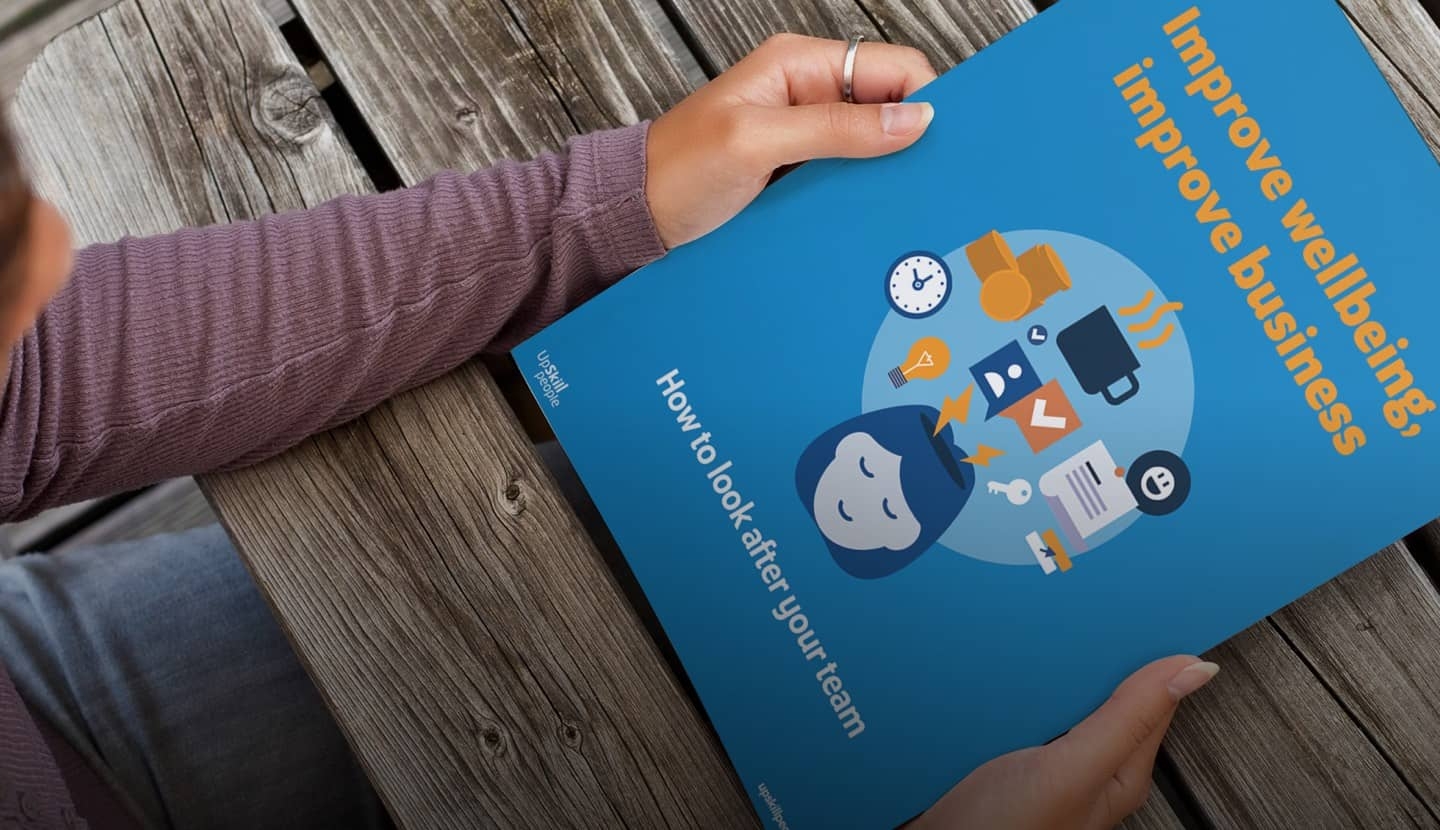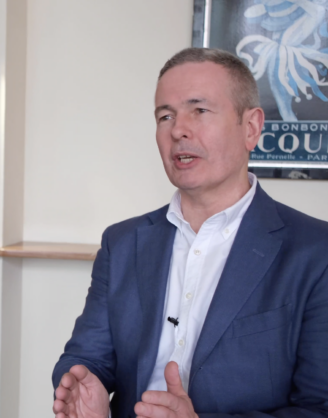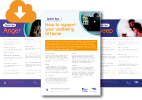Well people make for healthy businesses
Everyone knows how important wellbeing and mental resilience are in modern business. But is there anything you can actually do about these things, besides putting up some posters, hosting a few group sessions, and hoping for the best?
There’s nothing more frustrating than spending money on well-intentioned initiatives with no way of knowing if they’re doing any good. Well, in this case, it turns out there is something you can do that will get measurable results. I’ve written this guide for you to explain what is available now, how to deploy it effectively in your organisation, and crucially, how to measure its impact on your team.
My own team and I have been in the business of upskilling people – and measuring the impact – for well over 20 years. And that includes improving wellbeing, which is never more important than now. In this guide, I’m going to set out some very concrete and practical steps you can take to ensure your people are as aware, skilled and productive as they can be – and I’ll include details of the online courses available for you to use to address a range of challenges and opportunities.
Having used our online courses, Darren MacDonald, Retail Operations Director at The Works, summed up their experience: “Wellbeing online learning, it was absolutely the right thing to do.” His colleagues agreed: 96% believed their team’s overall performance would improve as a result. (Later I’ll explain how you can capture that kind of data about how your own team has benefitted from upskilling.
Smart employers know healthy employees are productive employees. It’s not just that stressed and anxious employees are more likely to take time off. It’s also that organisations where wellbeing is taken seriously bring out the best in people – and that’s as true when people are working from home as when they are on site. Generation Z and millennials especially need to feel valued and invested in. Effective learning for mental resilience is an effective way to help them flourish, improving motivation and retention as a result. Darren’s colleague at The Works, Operational Trainer Viki Tooth, puts it simply: “It costs a lot of money to find and recruit people; it doesn’t cost much to keep them.”
Taking Wellbeing Seriously
Forward-thinking employers see wellbeing as more than just another box to tick. They see it as a driver of value for the business. That means they treat it with the same seriousness they would apply to sales strategy, investment in technology or indeed recruitment itself. There’s little point bringing in the best talent on the market, if you then fail to make the most of it by helping people to flourish as rounded human beings who bring their whole selves to work.
Of course, achieving that involves investment, but less than you might think, and with a tangible return. Digital and online resources are a time and cost-efficient part of the mix for all modern organisations. For some, they are all it takes to make a real difference to their working culture, often as a supplement rather than a wholesale replacement for their existing learning and development programmes. So, what does a smart and savvy, 21st century approach to wellbeing at work actually look like?
Our forward-thinking clients told us they worried what they were previously using wasn’t cost effective and flexible enough. They wanted short courses for their entire team and something beyond the basics for their managers. So, we partnered with Mind and invested in developing an initial short series of six courses. Each course is around 10 minutes long, and the whole series together is a rapid and low risk way to upskill the entire team and demonstrate return on time and product investment. We’ve had some heart-warming individual feedback on the impact, and also seen tangible business improvements in hard figures, which I’ll cover later.
Online learning to nurture a well culture
Just as the safety of your people and customers should be part of the everyday culture of any well-run business, good physical and mental health needs to be front and centre to nurture a truly rounded and well team. Our courses ensure everyone is knowledgeable about all the key issues, and confident about supporting one another in tackling them when necessary. If they pass the courses, your people will be more resilient in facing challenges and better able to perform.
The courses include video, concise and easy to understand downloadable summaries and some video breathing exercises to learn and use repeatedly. A real-life scenario-based quiz verifies that the learner has done more than retain a few nuggets of information, but will be able to apply what they have learned in real-life situations. Crucially, all learning is tracked for analysis and measurement

Included in our courses:
 Your Wellbeing
Your Wellbeing
The first priority is simply getting your people thinking about wellbeing and how important it is to us all. Our no-nonsense course on ‘Your Wellbeing’ helps employees at all levels understand the importance of living in the present.
 What does the course cover?
What does the course cover?
It sets out how techniques ranging from practising ‘mindfulness’ to breathing exercises to simply going for a walk can help us all reconnect with ourselves and focus on what matters. This gives people the simple tools they need to improve their own wellbeing and cope with everyday challenges.
 What do people say after completing it?
What do people say after completing it?
“This course really demystified the whole idea of ‘wellbeing’ for me. Now I understand it’s not just a buzzword – it’s about practical ways we can all get some perspective and focus at work and at home.”
 What is Mental Health?
What is Mental Health?
It’s also important to ensure your people understand the facts about mental health. For example, they should understand that good mental health is not just about being free from mental illness. Our course on ‘What is Mental Health?’ covers all the facts and how to break the stigma.
 What does the course cover?
What does the course cover?
It explains it means being able to make the most of your potential, cope with life and play a full part in your family, community and workplace. It also shows learners how to recognise the most common mental health issues, and avoid using stigmatising language, in order to support colleagues who may need help.
 What do people say after completing it?
What do people say after completing it?
“I’ve always been a bit scared by the issue of mental health. It’s definitely not in my comfort zone. But the course is very straightforward and just 10 minutes helped me understand what it really means, and how we can talk about it at work. It had an impact straight away.”
When those common mental health issues do come up in the workplace, it’s important that colleagues are able to spot and understand them and then respond in the most effective and appropriate way. So, the series continues with three specific courses on depression, anxiety and stress.
Each course equips learners with the skills to recognise the issues relating to each topic, and what to do about them. Your people will be that much more confident in supporting their colleagues (and family and friends) and the result will be ever-increasing levels of good mental health, which means a better team and a better business.
 Understanding Depression
Understanding Depression
Understanding Depression explains the difference between depression as a natural response to disappointment and clinical depression, which is a debilitating mental health condition.
 What does the course cover?
What does the course cover?
It helps learners spot the signs and symptoms, understand different levels of severity and how to intervene effectively when required. This means depression can be dealt with before it leads to lost productivity and ongoing human misery.
 What do people say after completing it?
What do people say after completing it?
“I feel much more confident now I know the difference between depression and someone just having a bad day or week. If a colleague really is depressed, I know now how to spot the symptoms and what to do about it. Acting sooner rather than later is going to make a big difference.”
 Anxiety & Anxiety Disorders
Anxiety & Anxiety Disorders
Anxiety and Anxiety Disorders explains that while anxiety is a normal response to stress, it is not the same as stress. It becomes a mental disorder when we experience it for prolonged periods or on more days than not.
 What does the course cover?
What does the course cover?
The course sets out different types of anxiety disorder, their physical, psychological and behavioural symptoms, and effective treatments. The outcome is that learners are equipped to spot the signs and help colleagues overcome anxiety, so they can lead happy and productive lives.
 What do people say after completing it?
What do people say after completing it?
“I’ve seen colleagues overcome by anxiety before, but didn’t know what it was until now, or what to say except ‘don’t worry’ or ‘it’ll all be fine’. This course has shown me how I can actually help rather than just do nothing and hope it goes away or someone else steps in.”
 Let’s Talk About Stress
Let’s Talk About Stress
Let’s Talk About Stress explains that stress can be a good thing when it motivates us, but too much of it can literally make us ill, making it a major cause of absence from work.
 What does the course cover?
What does the course cover?
It sets out the signs and symptoms and includes practical advice on reducing stress, from being more realistic about work loads to sleeping and eating healthily and doing specific breathing exercises. It also includes tips on dealing with the particular challenges of working from home. Reduced stress improves overall wellbeing, attendance and productivity.
 What do people say after completing it?
What do people say after completing it?
“This course completely changed my view on what stress is. It was full of really practical advice about how to cope with everyday stress so it doesn’t have a long-term impact, and taught me that stress can actually be a positive, if understood and managed well. I love the breathing exercise!”
 Managing Mental Health
Managing Mental Health
Of course, managers have a particular responsibility when it comes to identifying issues and promoting wellbeing – especially given that we know good mental health increases productivity. Our course on Managing Mental Health helps managers understand the issues when it comes to looking after their people – including ‘presenteeism’ as well as absenteeism – and the best strategies for offering support.
 What does the course cover?
What does the course cover?
It also helps managers consider the different but equally important issues that can arise when people are working remotely and in isolation from their teams. While intended primarily for managers, Managing Mental Health can also give team members greater confidence in supporting their peers. The course raises the overall quality of leadership on this issue, adding value at all levels of an organisation.
 What do people say after completing it?
What do people say after completing it?
“Managing Mental Health has made me a better manager and a better colleague. I feel much more able to intervene effectively on an issue and offer practical advice and support. Where I previously would have felt out of my depth, worried I’d make things worse, now I can do something to help.”
 Violence & Aggression At Work
Violence & Aggression At Work
Other issues can also have bearing on wellbeing at work. For example, violence and aggression, whether from customers or other members of the public or between colleagues, can obviously have a detrimental effect on how your people feel and perform.
 What does the course cover?
What does the course cover?
Helps learners understand how frustration, resentment and misunderstandings (as well as a lack of knowledge and skills) can lead to tensions bubbling up, and equips them with techniques to prevent tensions escalating. This helps prevent and de-escalate incidents, fostering a more harmonious workplace, which in turn improves customer service, relationships and productivity.
 What do people say after completing it?
What do people say after completing it?
“Dealing with aggressive customers is the worst part of my job, and that includes ‘internal customers’. I can now understand each different situation, keep control and calm everyone down, so things don’t get out of hand.”
 Equality Essentials
Equality Essentials
Prejudice and discrimination of various kinds also undermine a wellbeing culture. So it’s important that everyone in a workplace feels equally valued, regardless of race, religion, sex or other characteristics. Equality issues can also be a source of conflict and stress, as offence can be taken even where it is not intended, and when it is, that amounts to bullying, which is a serious issue in its own right.
 What does the course cover?
What does the course cover?
They help learners understand the legal issues associated with the UK Equality Act. But beyond that, they explain how to deal with equality issues in a way that reinforces mental resilience and wellbeing – and how to deal with things before they escalate to tribunal or other legal challenges.
 What do people say after completing it?
What do people say after completing it?
“It’s very easy to say or do something you don’t realise has an impact. The course helped me understand how to recognise and overcome prejudice and discrimination, so everyone feels respected and valued. I can already see this boosting harmony and morale in our team.”
 Tackling Burnout
Tackling Burnout
 What does the course cover?
What does the course cover?
This course explains the rise in burnout and the feeling of being constantly swamped. It sets out how to recognise the emotional and physical signs and symptoms of burnout, and manager strategies to reduce team stress and prevent burnout. The outcome is that you’re equipped to reverse any damage and manage stress, and build resilience through taking care of your physical and emotional health.
 What do people say after completing it?
What do people say after completing it?
“Lorem ipsum sip dolor”
 Menopause In The Workplace
Menopause In The Workplace
Increasing our knowledge about menopause has tangible benefits. It fosters higher staff retention, as individuals feel understood and supported. It bolsters team morale, creating an inclusive and empathetic environment. It enables effective leadership, as leaders are equipped to address diverse issues. It reduces absenteeism, by addressing the physical and emotional challenges proactively. And importantly, it aids in decreasing the gender pay gap, as fewer women will feel compelled to leave or reduce their work hours.
 What does the course cover?
What does the course cover?
This short course is designed to upskill everyone to understand the reality of menopause, how to show empathy, be helpful and accommodating, and foster a caring culture. A culture that improves business performance by genuinely supporting its workforce.
 What do people say after completing it?
What do people say after completing it?
“Lorem ipsum sip dolor”
All these courses are designed to provide the ‘how’ as well as the ‘what’ in order to drive lasting behaviour change. And because outcomes can be measured, learners and their managers alike can see progress, which provides further motivation for both. Where assessments indicate the learner has not grasped something, they can easily repeat the course (whenever they like, on any device) until they’ve got it.

Learning teams can then report back with confidence that these interventions are making a real difference to people within the business. Further feedback is captured via post-course surveys that go beyond traditional ‘happy sheets’ to gauge learners’ responses on a range of measures, all anonymously. We’ll cover measuring learning to demonstrate progress towards your goals after we’ve considered your managers.
Upskill People’s learning platform also includes an ‘Easy Course Builder’ tool, which allows you to make your wellbeing series (and any other courses) just right for your organisation.
Available to help your team’s wellbeing and mental resilience:
Better Managers = Better Business
The single most important factor in creating, and maintaining a robust wellbeing culture is your managers.
Wellbeing is no different. It’s observations, interactions and day-to-day decisions made by managers that make the biggest difference: the decision to speak to a colleague who seems stressed and tetchy, and to do it sensitively; the decision to overlook a surly attitude and get to the bottom of the issue; the decision not to overlook a mistake, but to deal with it in context. These are not easy decisions, and even managers who know the right thing to do in theory will not always do it in practice.
Upskill People’s Managing People is a complete approach to creating great people managers, and measuring the impact. At its core are seven interactive online courses that harness the power of dramatic scenarios to prepare new managers for their role and update the skills of even the most experienced. The soap opera-like character of the scenarios means they are easy to remember and discuss with colleagues, providing a shared point of reference for ongoing learning and coaching.

Upskill People’s Managing People is a complete approach to creating great people managers, and measuring the impact. At its core are seven interactive online courses that harness the power of dramatic scenarios to prepare new managers for their role and update the skills of even the most experienced. The soap opera-like character of the scenarios means they are easy to remember and discuss with colleagues, providing a shared point of reference for ongoing learning and coaching.
Managing People, we wrote the book on it
So, what’s the book about? You’ll find a contemporary approach to developing managers explained, all in concise, plain language. The focus is on helping you design, produce, and deploy a programme that really delivers.
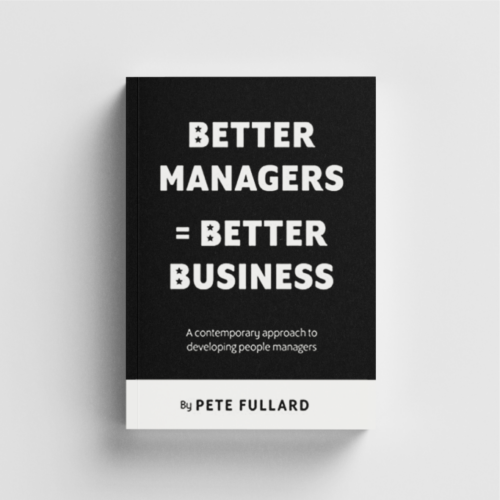
Measurement Essentials
 10 Minute Course Completion Time
10 Minute Course Completion Time
Your first decision on looking to deliver some new skills, is what kind of time investment do you want to make? Time really is money. When you decide to upskill your team, you need to consider how much of their time the organisation wants to invest. Regardless of whether you are buying or building content, you need to agree with the business leaders what time is acceptable. Even with a 10-minute course like our wellbeing ones, for a team of 1,000 people, this would represent 167 hours of learning. If they took 15 minutes, that would involve an extra 83 hours the business didn’t expect or plan for. We know from delivering millions of our courses how long they will take, but everyone is different, and if you’re deploying anything for the first time this is something to monitor carefully, especially in the initial weeks.
As well as an absolute goal, again, set tolerances. We would suggest 20% either side of your goal is a good range to aim for. What if you land outside your goal range? If everyone breezes through first time, perhaps they genuinely do already have the knowledge and skills, or they may have been rushing to get it done. No matter how much interactivity there is (and there should be a lot to engage the learner), the temptation is there for some. This is where the measure of quiz attempts comes in: how many times did it take them to pass the quiz. If people are passing only after multiple attempts, for example more than 2.5 on average, that indicates they’ve not digested and learned what they need from the course, but are simply repeating the quiz until they get a pass. This ‘ticks the box’ for course completion, but have they really learned anything, and will they change behaviour and show an improvement when you measure the impact later? Unlikely. So we always look for a range of between 1.5 and 2.4 as an average.

Another use of these measurements is to see if some teams, or indeed individuals, are taking significantly longer to complete a course (or requiring more attempts). If a large proportion of your audience is taking a lot longer than you expect, especially when combined with a high number of quiz attempts, it may indicate that one or more questions aren’t worded well (especially if some of your teams don’t have the language the course is written in as their first language), so a simple reword could be an easy improvement. The same results could also indicate that the information presented in the course doesn’t adequately cover the topic for them to answer some of the questions. If you spot it soon enough, and you have a really easy to update course building tool, this can be fixed immediately by analysing the data and seeing which questions they are getting wrong the most often (another measure we have within our courses and platform).
If the variations from your goals are isolated to countries, areas, teams, roles or individuals, then you can provide support and encouragement as required. Knowing what to measure and setting goals is exceptionally powerful, and will deliver significantly better outcomes. But there’s more to it than setting goals, waiting a few weeks or months and then reporting back. Measurement should be continuous, so you can compare results against your goals (final or interim). That way, if you’re off track, you can take action to get back on track. Ultimately, you get out what you put in. If you simply make a course available and leave it at that, you are unlikely to get the same results you would get if you launched the same course with an internal marketing campaign, encouraging your people to engage, learn and spread the word. Once you’ve recognised that an investment in upskilling goes beyond just deploying the courses, you can manage your risk, and are much more likely to shine and achieve success.
 Stats are one thing, but what do the learners think?
Stats are one thing, but what do the learners think?
And how do they feel? The next level of measurement is more qualitative, but it can also be quantified in hard numbers, which means you can set goals and hit them. Well-considered post-course surveys can tell you how your people feel about their learning, so decide what numbers you expect to be responding positively. When it comes to wellbeing, of course, this is particularly valuable and important. Here is an example set of data from a survey we conducted with The Works. After over 1 million minutes of online learning across the organisation, 97% said the courses were easy to use.
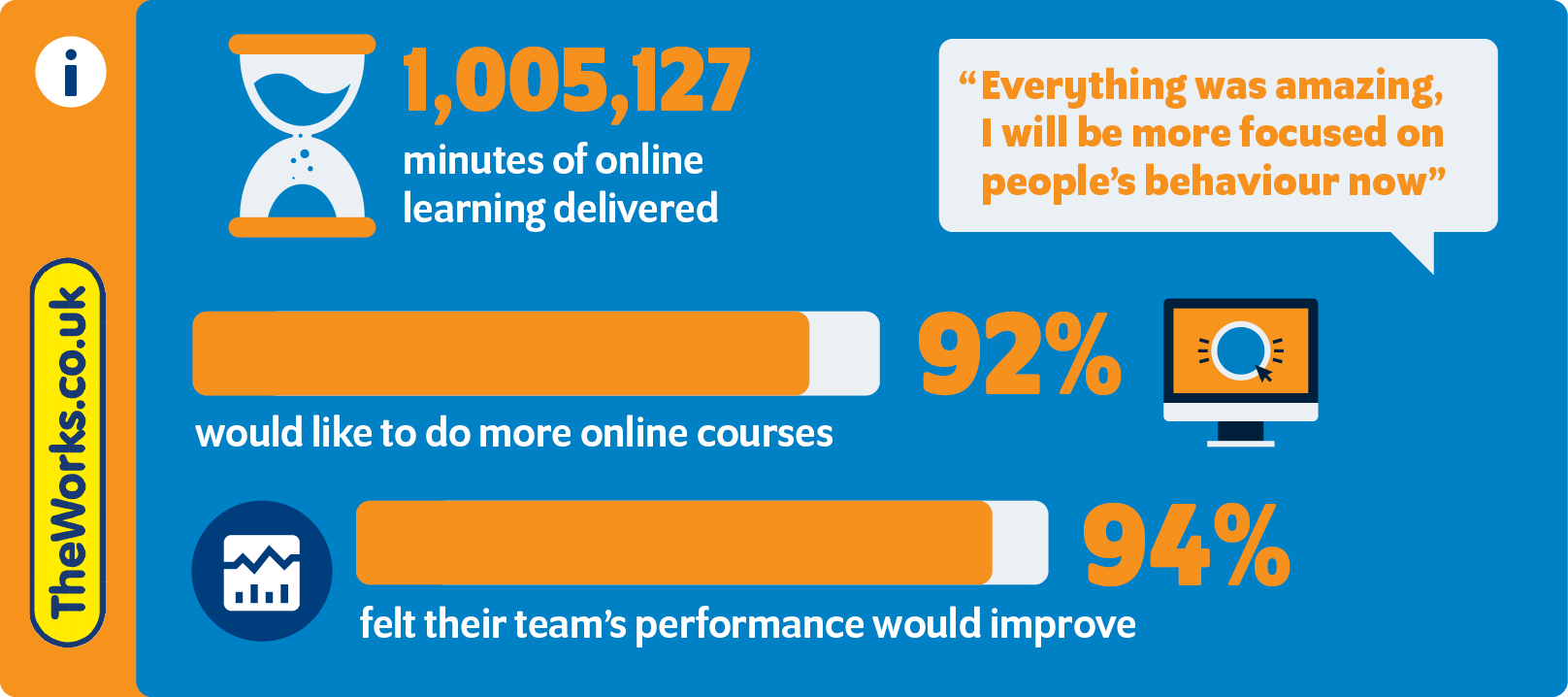
We use a standard set of post course survey questions, they are:
- Learning this way works for me
- The course was easy to use
- I learned knowledge and skills I could use
- The course was about the right length
- The course was well put together and easy to learn from
- I would like to do more work related courses like this
 Link it to business strategy and their goals
Link it to business strategy and their goals
Looking at learning measures and feedback alone is incredibly valuable. Nevertheless, there is one more thing to look at for the complete picture, especially where something tangible is measured, and that is the impact the learning has on the wider business. Some things are easy to measure, such as: sales, costs and service levels, as they’re measured by techniques like Net Promoter.
There are also more challenging measures. For example, we analyse the performance of our management courses, including Wellbeing, by mapping all the assessments to 7 competencies with 69 underlying behaviours. For wellbeing, there are a range of specific business measures you can look at. For example:
- Time taken off sick
- Feedback from employee engagement surveys
- Productivity gains
- Exit-interviews when people move on from the business
- Fewer disciplinary or legal issues (and associated costs)
So, this final level of measurement is the impact of learning on the wider organisation, which is a win for everyone involved. In the words of Zishan Amir, General Manager of Mega Adventure:
Setting clear goals means an improved wellbeing culture can be quantified, providing a clear indication of the value of this learning, and making a solid business case to convince the most sceptical of Boards. Some of this is very simple. Some is a little more complicated, but as you’ve seen, the results are more than worth it. So, whatever you’re doing in terms of learning, always set goals and test your learning against them. My team and I have shown time and again that good learning can be measured, and learning for wellbeing is no different.
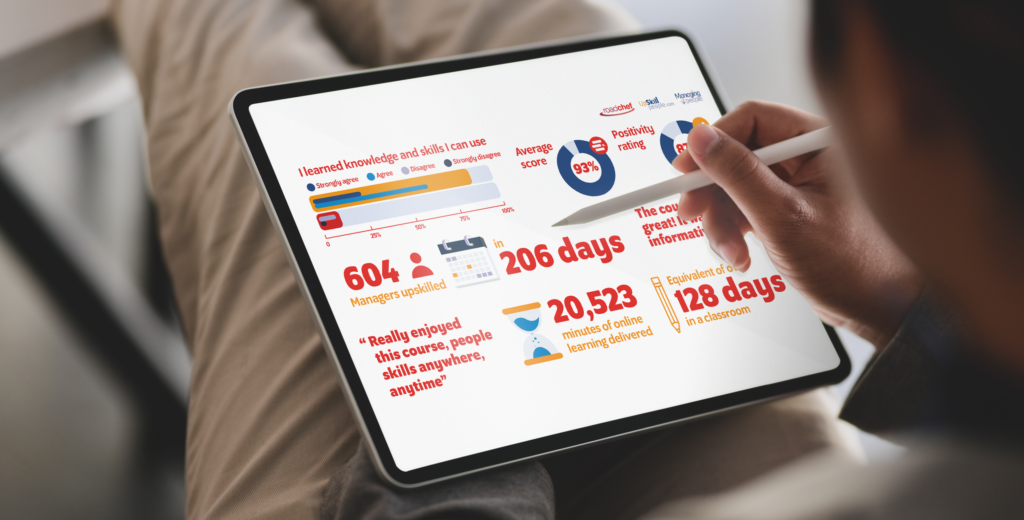
Everyday behaviours that promote wellbeing
Here are three key behaviours to nurture in your managers and their teams:
Awareness
Not so long ago mental health was a taboo issue. Even today, many managers understandably feel out of their depth and would rather avoid talking about it. But the fact is that most people experience mental health issues at some point in their lives, so inevitably they will sometimes come up in the workplace. Responsible employers must ensure everyone is aware of the most common issues – like stress, anxiety, and depression – and how best to respond to them. Managers must also learn to look out for changes in behaviour: people becoming distracted, harassed or frantic, snapping at colleagues or seeming to lose their sense of humour. And if complaints are raised against someone, or their performance declines, managers should consider the possibility that there’s an underlying issue, and seek to get to the bottom of it. Naturally, procedures should be in place to offer people help, including referral to professional help where appropriate, but those procedures will only count if people understand the issues and have the confidence to confront them.
Communication
Open-ended, everyday communication is essential to a healthy workplace. Managers need to be proactive in checking in with their people to see how they are, and to ensure they know they can raise any worries or concerns. When something seems to be amiss, patience and persistence are key to getting to the bottom of it – especially if people shrug off enquiries with an unconvincing ‘fine’. An informal approach is always best to begin. It is important not to put people on the defensive or to jump to conclusions. Equally, it may be necessary to set aside time to discuss things, and make sure people feel they are ‘safe’ and will not be interrupted. Managers need to practice active listening, which is a skill that must be learned. It means concentrating on what the other person is saying and taking time to check your understanding before responding. Effective communication also requires empathy. Talking about good mental health is a way of pre-empting discipline or censure, so people should not feel criticised or ‘got at’. They need to know they can bring up their worries without being judged, and that both the manager and the organisation understand people are not robots, and sometimes need a little compassion.
Taking Responsibility
It is a manager’s responsibility to act on concerns about a team member’s mental health – even if that person is reluctant to talk about it. Before making any decisions, though, they should make sure they have a full understanding of the team member’s own responsibilities and how they prioritise and complete their tasks. Whatever the decision, the manager should reassure the person that they are a valued member of the team – especially as feeling undervalued is a common reason people keep quiet when they’re struggling. They should also ensure the person feels included in the decision, understands the reasons and buys into it. Good managers should then review the situation regularly, checking in with the person on a daily basis, to show support and gauge whether further interventions might be beneficial.
Your Takeaways
Need to look after your team?
Get in touch
Take a little time for yourself
If you feel like you need a little time out, then be good to yourself and check out a short breathing exercise, to give you that extra little bit of calm in your busy day.

